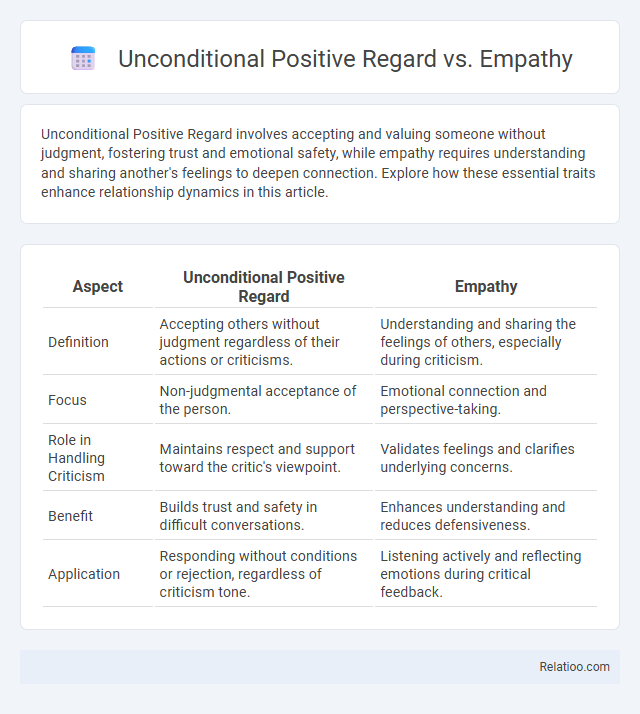Unconditional Positive Regard involves accepting and valuing someone without judgment, fostering trust and emotional safety, while empathy requires understanding and sharing another's feelings to deepen connection. Explore how these essential traits enhance relationship dynamics in this article.
Table of Comparison
| Aspect | Unconditional Positive Regard | Empathy |
|---|---|---|
| Definition | Accepting others without judgment regardless of their actions or criticisms. | Understanding and sharing the feelings of others, especially during criticism. |
| Focus | Non-judgmental acceptance of the person. | Emotional connection and perspective-taking. |
| Role in Handling Criticism | Maintains respect and support toward the critic's viewpoint. | Validates feelings and clarifies underlying concerns. |
| Benefit | Builds trust and safety in difficult conversations. | Enhances understanding and reduces defensiveness. |
| Application | Responding without conditions or rejection, regardless of criticism tone. | Listening actively and reflecting emotions during critical feedback. |
Understanding Unconditional Positive Regard
Understanding Unconditional Positive Regard involves accepting and valuing a person without judgment or conditions, fostering a safe environment conducive to personal growth. Unlike empathy, which requires sharing and understanding another's feelings, unconditional positive regard emphasizes nonjudgmental support regardless of behavior or emotions. This concept, rooted in Carl Rogers' humanistic psychology, is essential for therapeutic relationships and promotes self-acceptance and psychological well-being.
Defining Empathy in Practice
Empathy in practice involves genuinely understanding and sharing another person's feelings, creating a connection that goes beyond mere sympathy. This contrasts with unconditional positive regard, which emphasizes nonjudgmental acceptance of others regardless of their actions or feelings. Your ability to practice true empathy enhances communication and nurtures deeper relationships by validating emotions and fostering trust.
Historical Origins of the Concepts
Unconditional Positive Regard (UPR) was pioneered by Carl Rogers in the 1940s as a cornerstone of humanistic psychology, emphasizing complete acceptance without judgment. Empathy, with roots in phenomenology and Edith Stein's early 20th-century philosophical work, evolved as the ability to deeply understand another's experience by vicariously sharing their feelings. Your understanding of these concepts benefits from recognizing that UPR is a foundational therapeutic attitude, while empathy involves active emotional resonance, both essential in client-centered therapy's historical development.
Core Differences: Unconditional Positive Regard vs Empathy
Unconditional Positive Regard involves accepting and valuing a person without judgment, creating a safe environment for personal growth, while empathy focuses on deeply understanding and sharing another person's feelings from their perspective. You provide Unconditional Positive Regard to support someone's sense of self-worth irrespective of their actions, whereas empathy requires emotional resonance and cognitive engagement with their experience. The core difference lies in unconditional positive regard being a non-judgmental acceptance, whereas empathy is an active process of emotional connection and understanding.
Psychological Impact on Clients and Patients
Unconditional Positive Regard fosters a nonjudgmental, accepting environment that promotes self-acceptance and reduces client anxiety, essential for therapeutic progress. Empathy enables you to deeply understand and validate a client's emotional experience, facilitating stronger emotional connections and trust. While both concepts enhance psychological well-being, unconditional positive regard emphasizes consistent acceptance regardless of behavior, whereas empathy focuses on resonating with the client's feelings to support emotional healing.
Applications in Counseling and Therapy
Unconditional Positive Regard in counseling creates a nonjudgmental environment fostering client self-acceptance and growth, essential for person-centered therapy. Empathy involves the therapist deeply understanding and reflecting the client's feelings, facilitating emotional connection and validation critical in cognitive-behavioral and humanistic approaches. While both are foundational, Unconditional Positive Regard emphasizes acceptance without conditions, whereas empathy prioritizes emotional resonance and comprehension, enhancing therapeutic alliance and treatment outcomes.
Common Misconceptions and Overlaps
Unconditional Positive Regard (UPR) is often misunderstood as unconditional agreement or approval, but it actually refers to accepting and valuing a person without judgment, which differs from empathy that involves deeply understanding and sharing another's feelings. Both UPR and empathy overlap in fostering a supportive environment, yet empathy requires emotional resonance while UPR maintains nonjudgmental acceptance regardless of emotions expressed. Common misconceptions include equating UPR with empathy or assuming empathy implies endorsing behaviors, whereas UPR and empathy serve complementary but distinct roles in therapeutic and relational settings.
Benefits and Limitations of Each Approach
Unconditional Positive Regard fosters a non-judgmental environment that enhances self-acceptance and emotional growth but may overlook deeper emotional conflicts. Empathy allows therapists to deeply understand clients' feelings and experiences, promoting trust and connection, though it risks emotional burnout or blurred boundaries. Combining both approaches optimizes therapeutic outcomes by balancing acceptance with emotional insight, yet requires careful navigation to maintain professional detachment and effectiveness.
Integrating Both for Effective Communication
Integrating unconditional positive regard and empathy enhances effective communication by fostering a nonjudgmental environment where individuals feel valued and understood. Unconditional positive regard involves accepting others without conditions, while empathy entails deeply understanding and sharing another person's feelings. Combining both approaches promotes trust, openness, and meaningful dialogue in personal and professional relationships.
Choosing the Right Approach for Different Situations
Unconditional positive regard fosters a supportive environment by accepting individuals without judgment, essential in therapeutic or counseling settings for building trust and self-worth. Empathy involves understanding and sharing another's feelings, crucial in conflict resolution and emotional support to validate experiences and strengthen connections. Selecting between these approaches depends on context: unconditional positive regard is ideal for long-term relational growth, while empathy suits immediate emotional engagement and understanding.

Infographic: Unconditional Positive Regard vs Empathy
 relatioo.com
relatioo.com